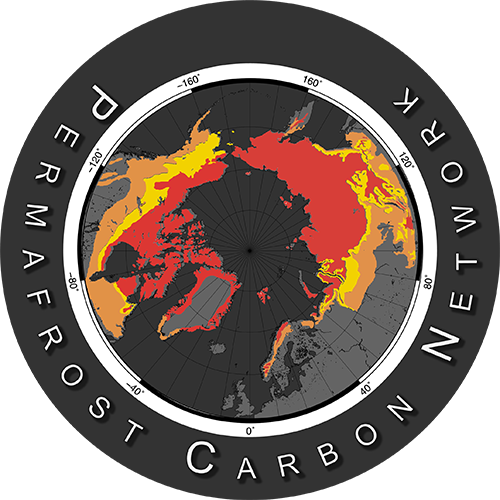 |
Permafrost Carbon Network |
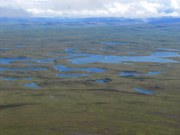
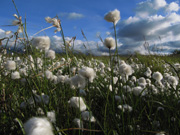
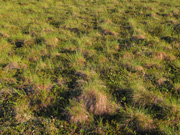
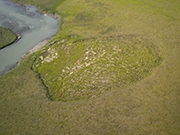
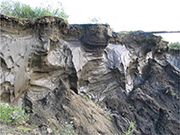
Our synthesis efforts include: Completed syntheses, synthesis of syntheses
Completed syntheses (chronological order, newest on top)
 |
We Must Stop Fossil Fuel Emissions to Protect Permafrost EcosystemsWe summarize terrestrial and marine changes in the permafrost domain with an eye toward global policy. Emissions reduction targets must be strengthened and accompanied by support for local peoples to protect intact ecological communities and natural carbon sinks within the permafrost domain. We call on leaders, corporations, researchers, and citizens everywhere to acknowledge the global importance of the permafrost domain and work towards climate restoration and empowerment of Indigenous and immigrant communities in these regions. Abbott BW, Brown M, Carey JC, Ernakovich J, Frederick JM, Guo L, Hugelius G, Lee RM, Loranty MM, Macdonald R, Mann PJ, Natali SM, Olefeldt D, Pearson P, Rec A, Robards M, Salmon VG, Sayedi SS, Schädel C, Schuur EAG, Shakil S, Shogren AJ, Strauss J, Tank SE, Thornton BF, Treharne R, Turetsky M, Voigt C, Wright N, Yang Y, Zarnetske JP, Zhang Q and Zolkos S 2022 We Must Stop Fossil Fuel Emissions to Protect Permafrost Ecosystems Frontiers in Environmental Science: https://www.frontiersin.org/article/10.3389/fenvs.2022.889428 |
 |
Microbiome assembly in thawing permafrost and its feedbacks to climateThis perspective piece describes the power of applying Assembly Theory to understanding microbial control of carbon and nitrogen cycling and climate feedbacks from thawing permafrost. The perspective proposes ideas about how disturbance intensity, time, and space affect the post-thaw microbiome as well as how these interact with the ecological and phylogenetic breadth of microbial functional guilds. From this, the authors predict the cumulative effects of assembly processes influencing the functioning of post-thaw ecosystem. Ernakovich JG, Barbato RA, Rich VI, Schädel C, Hewitt RE, Doherty SJ, Whalen ED, Abbott BW, Barta J, Biasi C, Chabot CL, Hultman J, Knoblauch C, Vetter MCYL, Leewis M-C, Liebner S, Mackelprang R, Onstott TC, Richter A, Schütte UME, Siljanen HMP, Taş N, Timling I, Vishnivetskaya TA, Waldrop MP and Winkel M (2022) Microbiome assembly in thawing permafrost and its feedbacks to climate Global Change Biology https://onlinelibrary.wiley.com/doi/abs/10.1111/gcb.16231 |
Subsea permafrost carbon stocks and climate change sensitivity estimated by expert assessmentWe performed a structured expert assessment with 25 permafrost researchers to combine quantitative estimates of the stocks and sensitivity of organic carbon in the subsea permafrost domain (i.e. unglaciated portions of the continental shelves exposed during the last glacial period). Experts estimated that the subsea permafrost domain contains ~560 gigatons carbon (GtC; 170–740, 90% confidence interval) in OM and 45 GtC (10–110) in CH4. Current fluxes of CH4 and carbon dioxide (CO2) to the water column were estimated at 18 (2–34) and 38 (13–110) megatons C yr−1, respectively. Sayedi SS, Abbott BW, Thornton BF, Frederick JM, Vonk JE, Overduin P, Schädel C, Schuur EAG, Bourbonnais A, Demidov N, Gavrilov A, He S, Hugelius G, Jakobsson M, Jones MC, Joung D, Kraev G, Macdonald RW, McGuire AD, Mu C, O’Regan M, Schreiner KM, Stranne C, Pizhankov E, Vasiliev A, Westermann S, Zarnetske JP, Zhang T, Ghandehari M, Baeumler S, Brown BC, Frei RJ (2020). Subsea permafrost carbon stocks and climate change sensitivity estimated by expert assessment. Environmental Research Letters, 15(12), 124075 https://doi.org/10.1088/1748-9326/abcc29 |
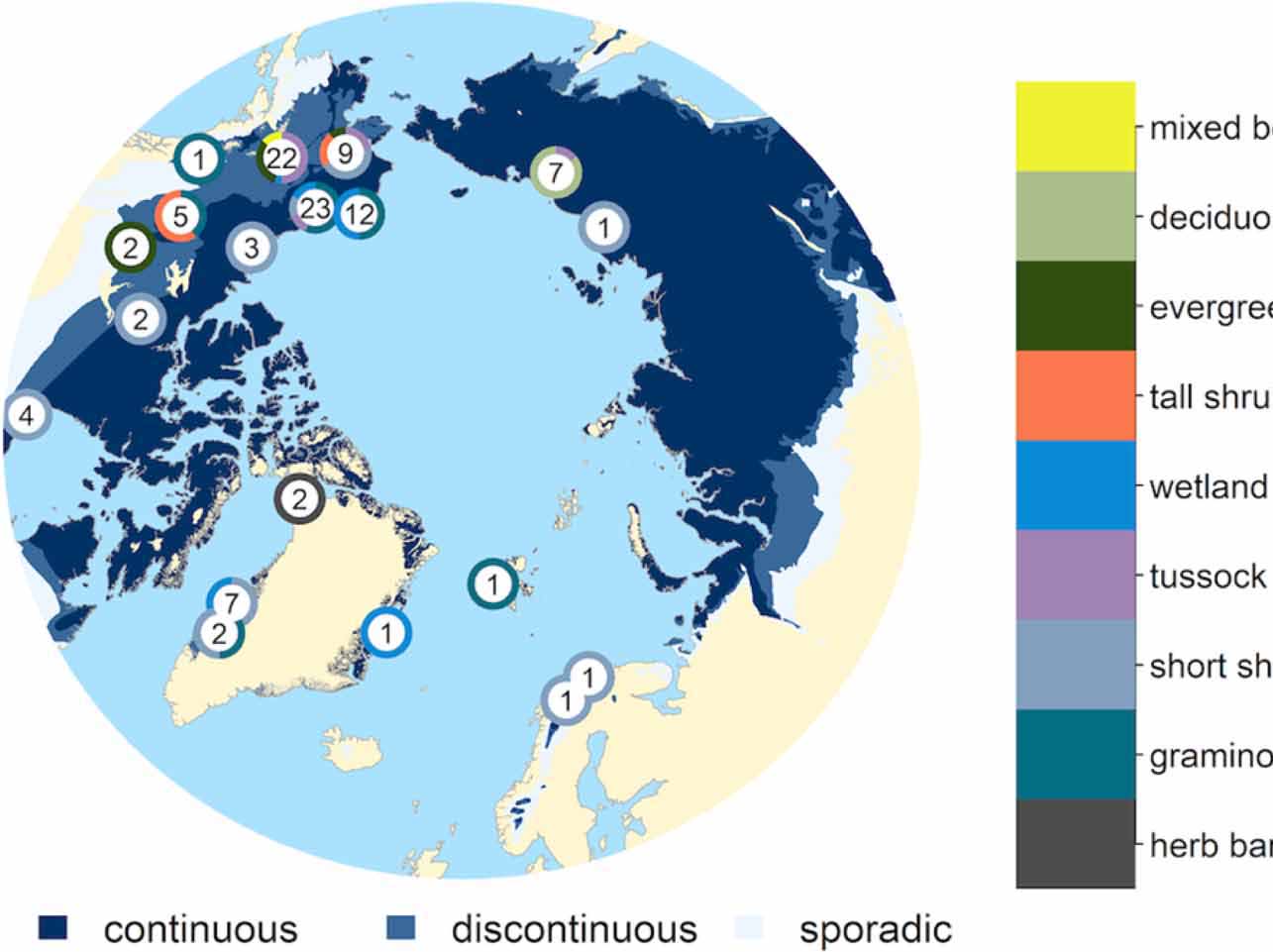 |
Shallow soils are warmer under trees and tall shrubs across Arctic and boreal ecosystemsWe synthesized shallow soil and air temperature observations with broad spatial and temporal coverage collected across 106 sites representing nine different vegetation types in the permafrost region. We showed ecosystems with tall-statured shrubs and trees (>40 cm) have warmer shallow soils than those with short-statured tundra vegetation when normalized to a constant air temperature. Kropp H, Loranty MM, Natali SM, Kholodov AL, Roch AV, Myers-Smith I, Abbott BW, Abermann J, Blanc-Betes E, Blok D, Blume-Werry G, Boike J, Breen AL, Cahoons SM, Christiansen CT, Douglas TA, Epstein HE, Frost GV, Goeckede M, Høye TT, Mamet ST, O’Donnell JA, Olefeldt D, Phoenix GK, Salmon VG, Sannel AB, Smith SL, Sonnentag O, Smith Vaughn L, Williams M, Elberling B, Gough L, Hjort J, Lafleur PM, Euskirchen ES, Heijmans MMPD, Humphreys ER, Iwata H, Jones BM, Jorgenson MT, Grünberg I, Kim Y, Laundre J, Mauritz M, Michelsen A, Schaepman-Strub G, Tape KD, Ueyama M, Lee B-Y, Langley K, Lund M (2020). Shallow soils are warmer under trees and tall shrubs across Arctic and Boreal ecosystems. Environmental Research Letters, 16(1), 015001. https://doi.org/10.1088/1748-9326/abc994
|
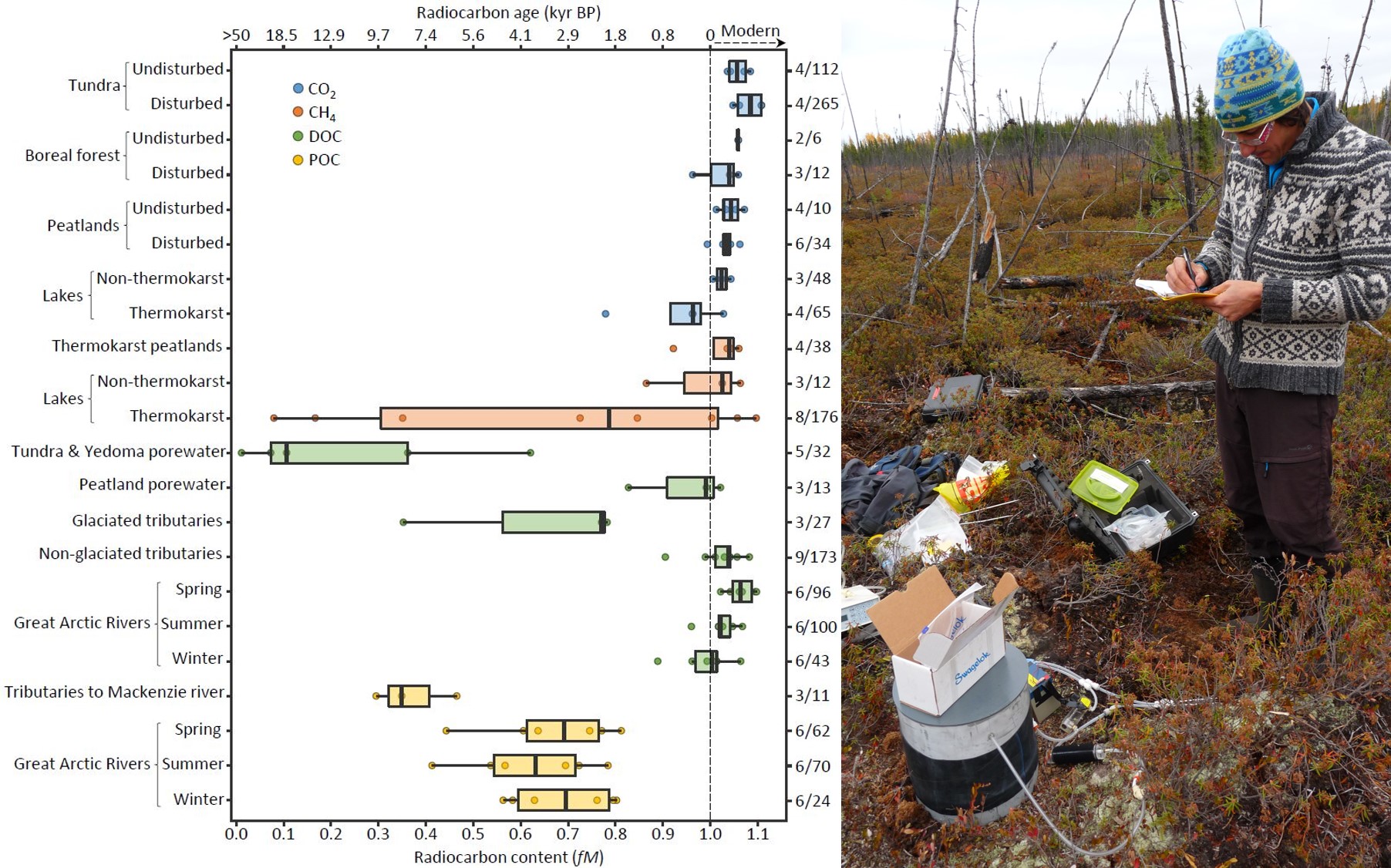 |
Assessing the Potential for Mobilization of Old Soil Carbon after Permafrost Thaw: A Synthesis of 14C Measurements from the Northern Permafrost RegionWe compiled ~1,900 14C measurements from 51 sites in the northern permafrost region to assess the vulnerability of thawing SOC in tundra, forest, peatland, lake, and river ecosystems. We found that growing season soil 14C‐CO2 emissions generally had a modern (post‐1950s) signature, but that well‐drained, oxic soils had increased CO2 emissions derived from older sources following recent thaw. This synthesis thus suggests widespread but not universal release of permafrost SOC following thaw. Estop‐Aragonés C, Olefeldt D, Abbott BW, Chanton JP, Czimczik CI, Dean JF, Egan JE, Gandois L, Garnett MH, Hartley IP, Hoyt A, Lupascu M, Natali SM, O’Donnell JA, Raymond PA, Tanentzap AJ, Tank SE, Schuur EAG, Turetsky M, & Anthony KW (2020). Assessing the Potential for Mobilization of Old Soil Carbon after Permafrost Thaw: A Synthesis of 14C Measurements from the Northern Permafrost Region. Global Biogeochemical Cycles, e2020GB006672. https://doi.org/10.1029/2020GB006672 |
 |
Soil moisture and hydrology projections of the permafrost regionWidely-used land models project near-surface drying of the terrestrial Arctic despite increases in the net water balance driven by climate change. Drying was generally associated with increases of active-layer depth and permafrost thaw in a warming climate. However, models lack important mechanisms such as thermokarst and soil subsidence that will change the hydrological regime and add to the large uncertainty in the future Arctic hydrological state and the associated permafrost carbon feedback. Andresen CG, Lawrence DM, Wilson CJ, McGuire AD, Koven C, Schaefer K, Jafarov E, Peng S, Chen X, Gouttevin I, Burke E, Chadburn S, Ji D, Chen G, Hayes D, & Zhang W. (2020). Soil moisture and hydrology projections of the permafrost region – a model intercomparison. The Cryosphere, 14(2), 445–459. https://doi.org/10.5194/tc-14-445-2020 |
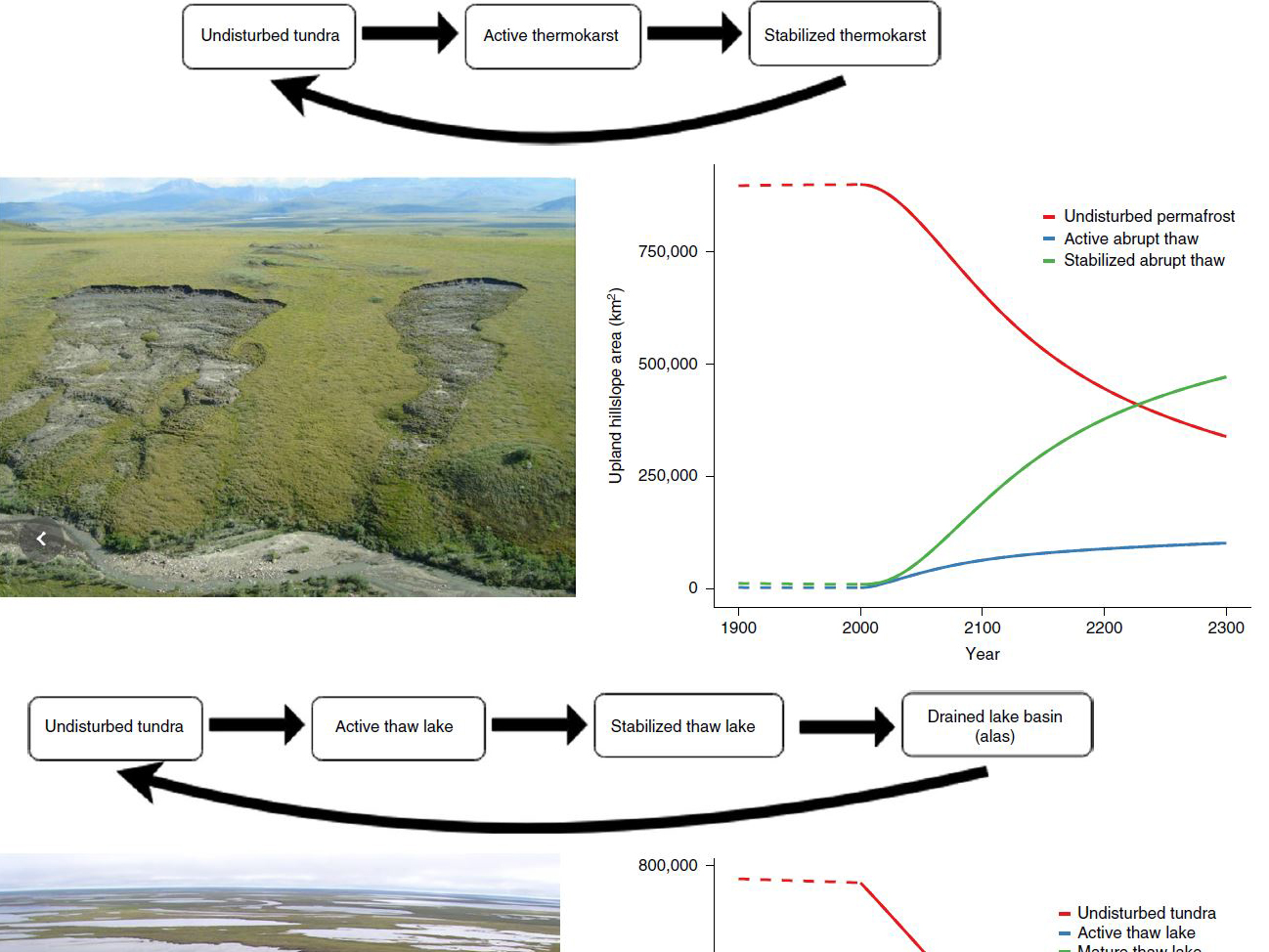 |
Carbon loss through abrupt permafrost thawThis synthesis provides a first estimate of thermokarst (abrupt thaw) carbon emissions using numerical models. Abrupt thaw occurs in <20% of the permafrost zone but could double permafrost carbon emissions. This 7 year project arose from multiple breakout rounds and discussions during our annual meetings prior to AGU and is a prime example of a collaborative effort bringing together the various expertises amongst the members of our network. Turetsky MR, Abbott BW, Jones MC, Anthony KW, Olefeldt D, Schuur EAG, Grosse G, Kuhry P, Hugelius G, Koven C, Lawrence DM, Gibson C, Sannel ABK, & McGuire AD (2020). Carbon release through abrupt permafrost thaw. Nature Geoscience, 13(2), 138–143. https://doi.org/10.1038/s41561-019-0526-0 |
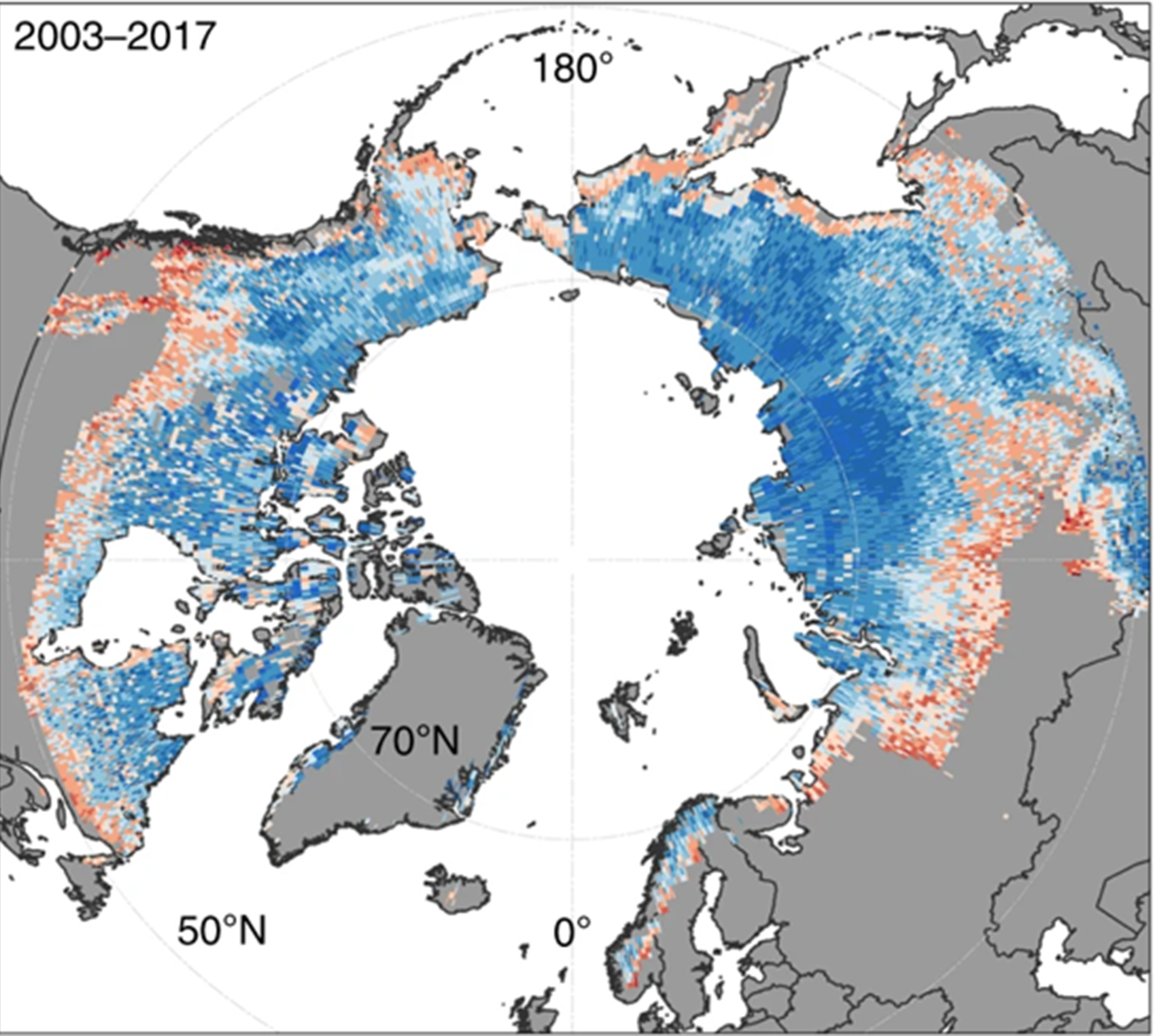 |
Large loss of CO2 in winter observed across the northern permafrost regionThis new synthesis provides a baseline for winter CO2 emissions from northern terrestrial regions and indicates that enhanced soil CO2 loss due to winter warming may offset growing season carbon uptake under future climatic conditions. Natali SM, Watts JD, Rogers BM, Potter S, Ludwig SM, Selbmann A.-K, Sullivan PF, Abbott BW, Arndt KA, Birch L, Björkman MP, Bloo, AA, Celis G, Christensen TR, Christiansen CT, Commane R, Cooper EJ, Crill P, Czimczik C, Davydov S, Du J, Egan JE, Elberling B, Euskirchen ES, Friborg T, Genet H, Göckede M, Goodrich JP, Grogan P, Helbig M, Jafarov EE, Jastrow JD, Kalhori AAM, Kim Y, Kimball JS, Kutzbach L, Lara MJ, Larsen KS, Lee B.-Y, Liu Z, Loranty MM, Lund M, Lupascu M, Madani N, Malhotra A, Matamala R, McFarland J, McGuire AD, Michelsen A, Minions C, Oechel WC, Olefeldt D, Parmentier F.-JW, Pirk N, Poulter B, Quinton W, Rezanezhad F, Risk D, Sachs T, Schaefer K, Schmidt NM, Schuur EAG, Semenchuk PR, Shaver G, Sonnentag O, Starr G, Treat CC, Waldrop MP, Wang Y, Welker J, Wille C, Xu X, Zhang Z, Zhuang Q, and Zona D. 2019 Large loss of CO2 in winter observed across the northern permafrost region, Nature Clim. Change, 1–6, doi:10.1038/s41558-019-0592-8, 2019. |
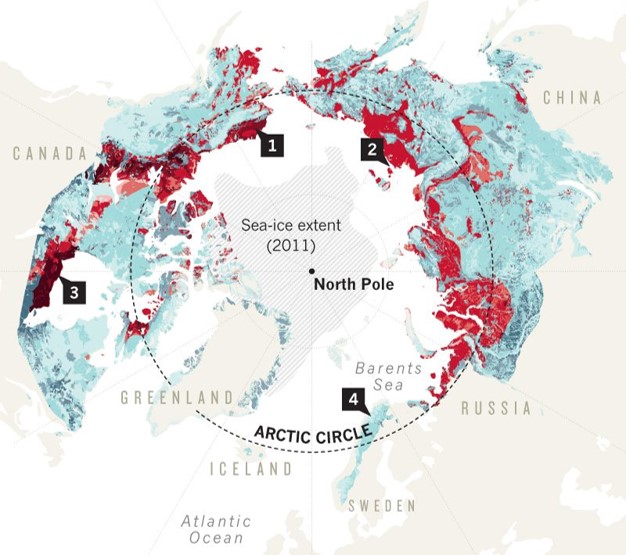 |
PermafrosT Collapse is accelerating carbon releaseThe sudden collapse of thawing soils in the Arctic might double the warming from greenhouse gases released from tundra. This Nature Comment shows results that researchers put together from abrupt thaw studies from a range of environments across the permafrost zone to estimate the overall effect.The author team calls for more measurement and monitoring of Arctic permafrost, as well as improved modeling and reporting of effects of thaw on climate. Turetsky MR, Abbott BW, Jones MC, Anthony KW, Olefeldt D, Schuur EAG, Koven C, McGuire AD, Grosse G, Kuhry P, Hugelius G, Lawrence DM, Gibson C and Sannel ABK 2019 Permafrost collapse is accelerating carbon release Nature 569 32. doi:10.1038/d41586-019-01313-4 |
Reviews and syntheses: Changing ecosystem influences on soil thermal regimes in northern high-latitude permafrost regionsVegetation and soils strongly influence ground temperature in permafrost ecosystems across the Arctic and sub-Arctic. These effects will cause differences rates of permafrost thaw related to the distribution of tundra and boreal forests. As the distribution of forests and tundra change, the effects of climate change on permafrost will also change. We review the ecosystem processes that will influence permafrost thaw and outline how they will feed back to climate warming. Loranty MM, Abbott BW, Blok D, Douglas TA, Epstein HE, Forbes BC, Jones BM, Kholodov AL, Kropp H, Malhotra A, Mamet SD, Myers-Smith IH, Natali SM, O’Donnell JA, Phoenix GK, Rocha AV, Sonnentag O, Tape KD and Walker DA 2018 Reviews and syntheses: Changing ecosystem influences on soil thermal regimes in northern high-latitude permafrost regions Biogeosciences 15 5287–313. https://doi.org/10.5194/bg-15-5287-2018 |
 |
Dependence of the evolution of carbon dynamics in the northern permafrost region on the trajectory of climate changeIn this model intercomparison project, changes in permafrost and carbon storage in the northern permafrost region are simulated from 2010 to 2299. The results show that controlling greenhouse gas emissions in the coming decades could substantially reduce the consequences of carbon releases from thawing permafrost during the next 300 years. McGuire AD, Lawrence DM, Koven CD, Clein J, Burke EJ, Chen G, Jafarov E, MacDougall A, Marchenko S, Nicolsky D, Peng S-S, Rinke A, Ciais P, Gouttevin I, Hayes D, Ji D, Krinner G, Moore J, Romanovsky V, Schädel C, Schaefer K, Schuur EAG, Zhuang Q (2018) The dependence of the evolution of carbon dynamics in the Northern Permafrost Region on the trajectory of climate change Proceedings of the National Academy of Sciences, 115, (15), 3882-3887 https://doi.org/10.1073/pnas.1719903115 |
 |
Deep Yedoma permafrost: A synthesis of depositional characteristics and carbon vulnerabilityThis review summarizes and evaluates existing hypotheses on Yedoma genesis, the age of deposits and organic carbon stored in Yedoma, and evaluates datasets on Yedoma carbon quantity and quality Strauss J, Schirrmeister L, Grosse G, Fortier D, Hugelius G, Knoblauch C, Romanovsky V, Schädel C, von Deimling TS, Schuur EAG, Shmelev D, Ulrich M, Veremeeva A. Deep Yedoma permafrost: A synthesis of depositional characteristics and carbon vulnerability. Earth-Science Reviews. https://doi.org/10.1016/j.earscirev.2017.07.007 |
 |
Circumpolar distribution and carbon storage of thermokarst landscapesNew map allows scientists to predict future greenhouse gas emissions that follow permafrost thaw Olefeldt D, Goswami S, Grosse G, Hayes D, Hugelius G, Kuhry P, McGuire AD, Romanovsky VE, Sannel ABK, Schuur EAG, Turetsky MR (2016) Circumpolar distribution and carbon storage of thermokarst landscapes. Nature Communications, 7, 13043. doi:10.1038/ncomms13043 |
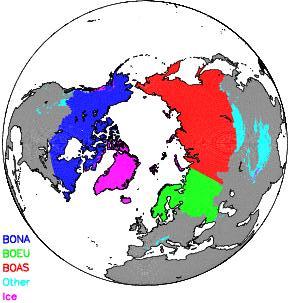 |
Variability in the sensitivity among model simulations of permafrost and carbon dynamics in the permafrost region between 1960 and 2009A retrospective analysis of 15 land surface model simulations including carbon cycle processes and permafrost for 1960-2009. McGuire AD, Koven C, Lawrence DM, Clein JS, Xia J, Beer C, Burke E, Chen G, Chen X, Delire C, Jafarov E, MacDougall AH, Marchenko S, Nicolsky D, Peng S, Rinke A, Saito K, Zhang W, Alkama R, Bohn TJ, Ciais P, Decharme B, Ekici A, Gouttevin I, Hajima T, Hayes DJ, Ji D, Krinner G, Lettenmaier DP, Luo Y, Miller PA, Moore JC, Romanovsky V, Schädel C, Schaefer K, Schuur EAG, Smith B, Sueyoshi T, Zhuang Q (2016) Variability in the sensitivity among model simulations of permafrost and carbon dynamics in the permafrost region between 1960 and 2009. Global Biogeochemical Cycles. doi:10.1002/2016GB005405 |
 |
Potential carbon emissions dominated by carbon dioxide from thawed permafrost soilsCarbon emissions from aerobic and anaerobic incubation studies and with increases in temperature, two meta-analyses Schädel C, Bader MKF, Schuur EAG, Biasi C, Bracho R, Čapek P, De Baets S, Diáková K, Ernakovich J, Estop-Aragones C, Graham DE, Hartley IP, Iversen CM, Kane E, Knoblauch C, Lupascu M, Martikainen PJ, Natali SM, Norby RJ, O/'Donnell JA, Chowdhury TR, Šantrůčková H, Shaver G, Sloan VL, Treat CC, Turetsky MR, Waldrop MP, Wickland KP (2016) Potential carbon emissions dominated by carbon dioxide from thawed permafrost soils. Nature Clim. Change, 6, 950-953. doi:10.1038/nclimate3054 |
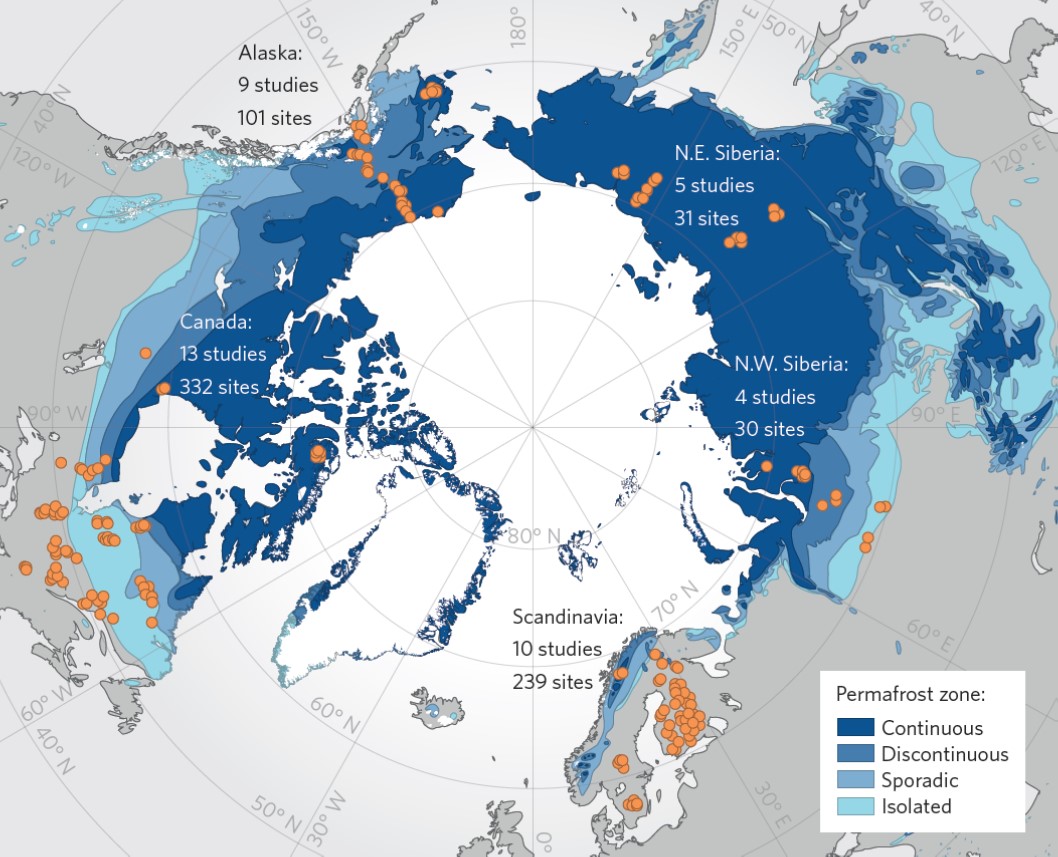 |
Climate-sensitive northern lakes and ponds are critical components of methane releaseImprovements in current estimates and future predictions of CH4 emissions from northern lakes and ponds Wik M, Varner RK, Anthony KW, MacIntyre S, Bastviken D (2016) Climate-sensitive northern lakes and ponds are critical components of methane release. Nature Geosci, https://doi.org/10.1038/ngeo2578 |
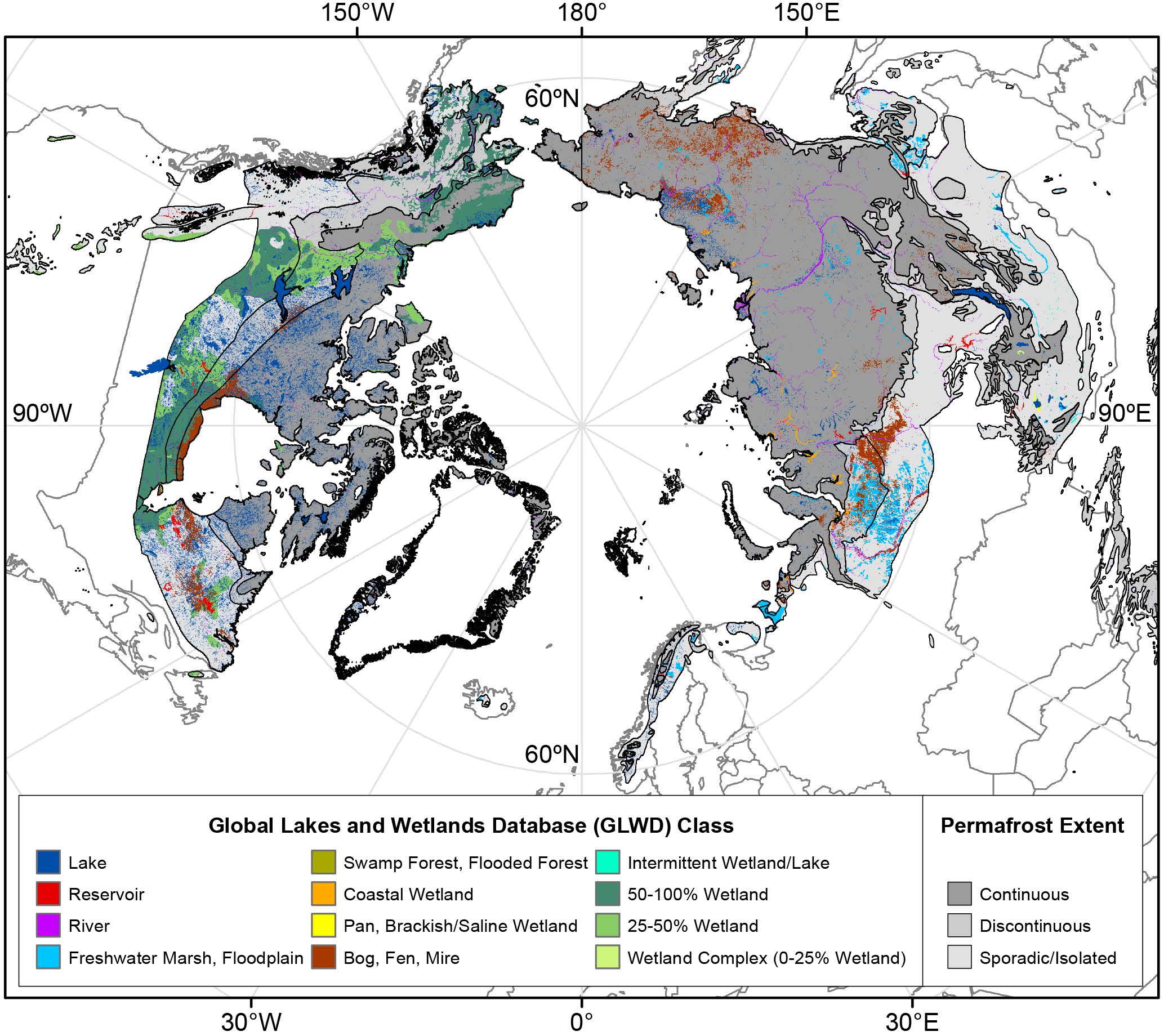 |
Reviews and syntheses: Effects of permafrost thaw on Arctic aquatic ecosystemsGeneral impacts of thaw on aquatic ecosystems, pathways of organic matter and contaminant release and degradation, resulting emissions and burial, and effects on ecosystem structure and functioning Vonk JE, Tank SE, Bowden WB, Laurion I, Vincent WF, Alekseychik P, Amyot M, Billet MF, Canário J, Cory RM, Deshpande BN, Helbig M, Jammet M, Karlsson J, Larouche J, MacMillan G, Rautio M, Walter Anthony KM, Wickland KP (2015) Reviews and syntheses: Effects of permafrost thaw on Arctic aquatic ecosystems. Biogeosciences, 12, 7129-7167. doi: 10.5194/bg-12-7129-2015 |
 |
A pan-Arctic synthesis of CH4 and CO2 production from anoxic soil incubationsA synthesis on how environemental and ecological drivers affect CH4 and anaerobic CO2 production from soils of the permafrost region. Treat C, Natali SM, Ernakovich J, Iversen CM, Lupascu M, McGuire AD, Norby RJ, Roy Chowdhury T, Richter A, Šantrůčková H, Schädel C, Schuur EAG, Sloan VL, Turetsky MR, Waldrop MP (2015) A pan-Arctic synthesis of CH4 and CO2 production from anoxic soil incubations. Global Change Biology. doi:10.1111/gcb.12875 |
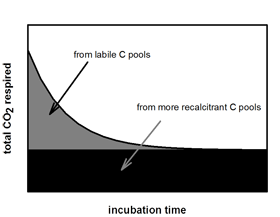 |
Circumpolar assessment of permafrost C quality and its vulnerability over time using long-term incubation dataSynthesizes the decomposability of permafrost organicmatter using incubation data and calculates potential carbon loss for high-latitude soils. Schädel C, Schuur EAG, Bracho R, Elberling B, Knoblauch C, Lee H, Luo Y, Shaver GR, Turetsky MR (2014) Circumpolar assessment of permafrost C quality and its vulnerability over time using long-term incubation data. Global Change Biology, 20, 641-652. doi: 10.1111/gcb.12417 |
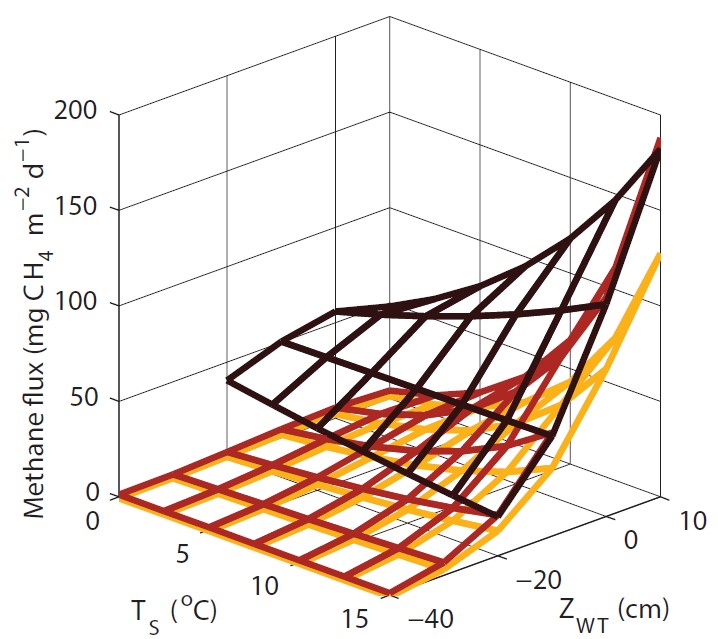 |
Environmental and physical controls on northern terrestrial methane emissions across permafrost zonesSynthesis of data on growing-seasonCH4emissions fromterrestrial ecosystems across permafrost zones Olefeldt, D., Turetsky MR, Crill PM & McGuire AD Environmental and physical controls on northern terrestrial methane emissions across permafrost zones. Global Change Biology 19, 589-603, (2013). doi: 10.1111/gcb.12071 |
 |
Estimated stocks of circumpolar permafrost carbon with quantified uncertainty ranges and identified data gapsRevised and updated current state of knowledge on permafrost soil organic carbon stocks at circumpolar scales. Hugelius G, Strauss J, Zubrzycki S, Harden JW, Schuur EAG, Ping C-L, Schirrmeister L, Grosse G, Michaelson GJ, Koven CD, O'Donnell JA, Elberling B, Mishra U, Camill P, Yu Z, Palmtag J, and Kuhry P (2014) Estimated stocks of circumpolar permafrost carbon with quantified uncertainty ranges and identified data gaps. Biogeosciences, 11, 6573-6593. doi:10.5194/bg-11-6573-2014 |
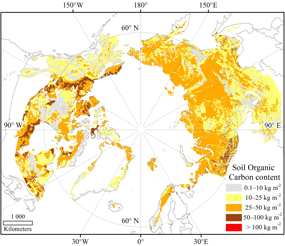 |
The Northern Circumpolar Soil Carbon Database (NCSCD):Descriotion of the compliation of the NCSCD spatial framework, the soil sampling and soil analytical procedures used to dervive soil organic carbon content in pedons from North America and Eurasia. Download the data polygon based GIS data (shape-files) Hugelius G, Tarnocai C, Broll G, Canadell JG, Kuhry P, Swanson DK (2013) The Northern Circumpolar Soil Carbon Database: spatially distributed datasets of soil coverage and soil carbon storage in the northern permafrost regions. Earth System Science Data, 5, 1. doi: 10.5194/essd-5-3-2013 |
 |
The Deep Permafrost Carbon Pool of the Yedoma Region in Siberia and AlaskaQuantification of the organic carbon pool for Yedoma and thermokarst deposits, based on field data and extrapolations using geospatial data. Strauss J, Schirrmeister L, Grosse G, Wetterich S, Ulrich M, Herzschuh U, Hubberten H-W (2013) The Deep Permafrost Carbon Pool of the Yedoma Region in Siberia and Alaska. Geophysical Research Letters, 2013GL058088, doi: 10.1002/2013gl058088 |
 |
Field information links permafrost carbon to physical vulnerabilities of thawingProvides cumulative distributions of active layer thickness under current and future climates and estimates the amounts of newly thawed carbon and nitrogen. Harden JW, Koven CD, Ping C-L, Hugelius G, McGuire AD, Camill P, Jorgenson T, Kuhry P, Michaelson GJ, O'Donnell JA, Schuur EAG, Tarnocai C, Johnson K, Grosse G (2012) Field information links permafrost carbon to physical vulnerabilities of thawing. Geophysical Research Letters, 39. doi:10.1029/2012gl051958 |
syntheses of syntheses (chronological order, newest on top)
 |
A simplified, data-constrained approach to estimate the permafrost carbon–climate feedbackEstimation of the feedback from large-scale thawing of permaforst soils using a simplified, data-contrained model that combines three elements: soil carbon maps and profiles, incubation experiments, and models of soil thermal dynamics in response to climate warming. Koven CD, Schuur EAG, Schädel C, Bohn TJ, Burke EJ, Chen G, Chen X, Ciais P, Grosse G, Harden JW, Hayes DJ, Hugelius G, Jafarov EE, Krinner G, Kuhry P, Lawrence DM, Macdougall AH, Marchenko SS, Mcguire AD, Natali SM, Nicolsky DJ, Olefeldt D, Peng S, Romanovsky VE, Schaefer KM, Strauss J, Treat CC, Turetsky M (2015) A simplified, data-constrained approach to estimate the permafrost carbon–climate feedback. Philosophical Transactions of the Royal Society of London A: Mathematical, Physical and Engineering Sciences, 373, DOI: 10.1098/rsta.2014.0423 |
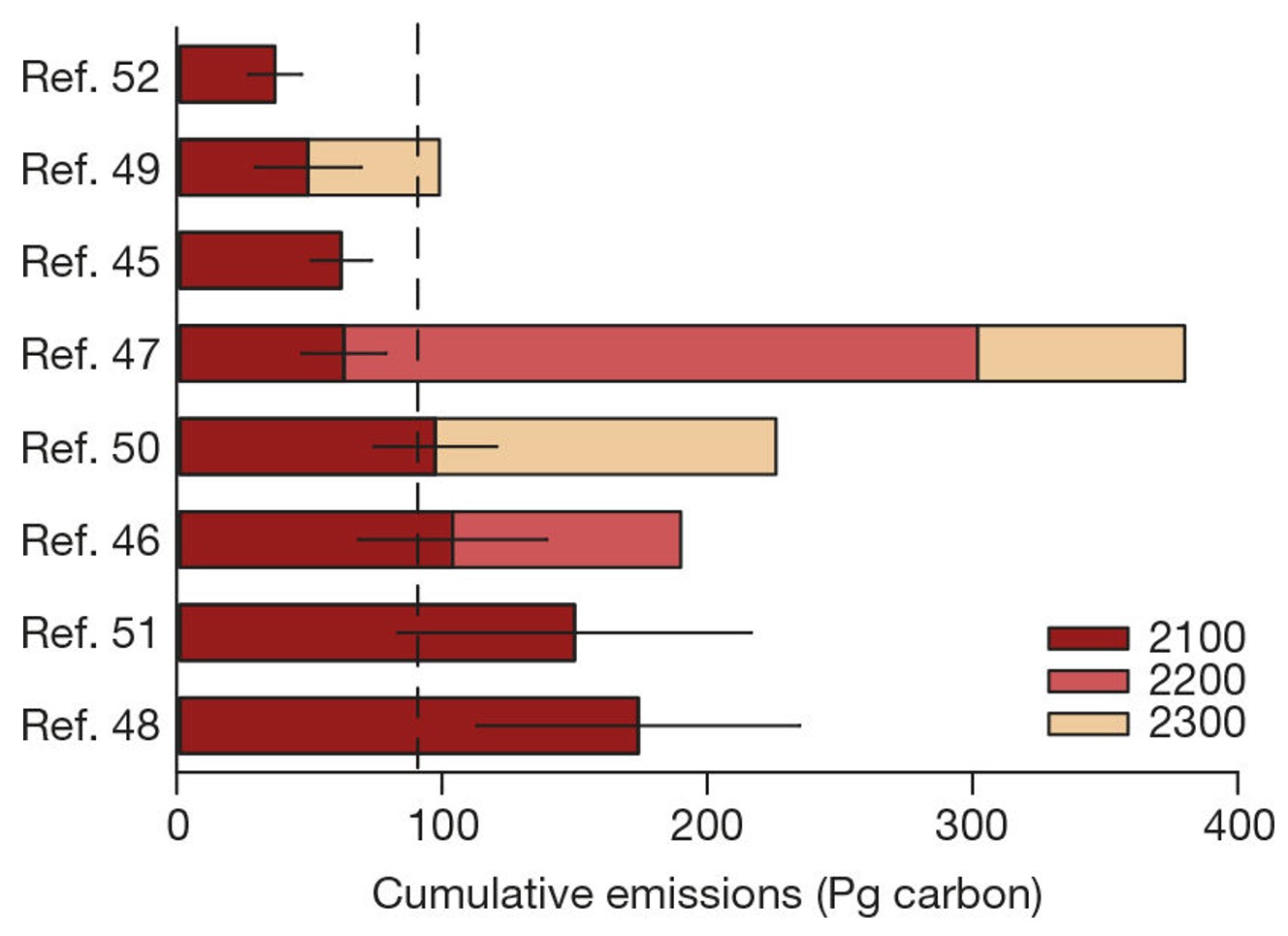 |
Climate change and the permafrost carbon feedbackAn overview of new insights from a multi-year synthesis of data with the aim of constraining our current understanding of the permafrost carbon feedback to climate, and providing a framework for developing research initiatives in the permafrost region. Schuur, EAG, McGuire AD, Schädel C, Grosse G., Harden JW, Hayes DJ, Hugelius G, Koven CD, Kuhry P, Lawrence DM, Natali SM, Olefeldt C, Romanovsky VE, Schaefer K, Turetsky MR, Treat CC and Vonk JE (2015). Climate change and the permafrost carbon feedback. Nature 520 (7546): 171-179. doi:10.1038/nature14338 |
back to top

